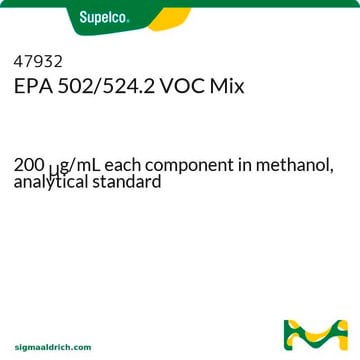48624
Bromomethane solution
certified reference material, 200 μg/mL in methanol
Synonim(y):
Methyl bromide
About This Item
Polecane produkty
klasa czystości
certified reference material
TraceCERT®
linia produktu
TraceCERT®
Certyfikat analizy
current certificate can be downloaded
opakowanie
ampule of 1 mL
stężenie
200 μg/mL in methanol
metody
HPLC: suitable
gas chromatography (GC): suitable
Zastosowanie
agriculture
environmental
format
single component solution
temp. przechowywania
2-8°C
ciąg SMILES
CBr
InChI
1S/CH3Br/c1-2/h1H3
Klucz InChI
GZUXJHMPEANEGY-UHFFFAOYSA-N
Szukasz podobnych produktów? Odwiedź Przewodnik dotyczący porównywania produktów
Powiązane kategorie
Opis ogólny
Zastosowanie
Inne uwagi
Informacje prawne
Hasło ostrzegawcze
Danger
Zwroty wskazujące rodzaj zagrożenia
Zwroty wskazujące środki ostrożności
Klasyfikacja zagrożeń
Acute Tox. 3 Dermal - Acute Tox. 3 Inhalation - Acute Tox. 3 Oral - Flam. Liq. 2 - STOT SE 1
Organy docelowe
Eyes,Central nervous system
Kod klasy składowania
3 - Flammable liquids
Klasa zagrożenia wodnego (WGK)
WGK 2
Temperatura zapłonu (°F)
51.8 °F - closed cup
Temperatura zapłonu (°C)
11 °C - closed cup
Środki ochrony indywidualnej
Eyeshields, Faceshields, Gloves
Choose from one of the most recent versions:
Masz już ten produkt?
Dokumenty związane z niedawno zakupionymi produktami zostały zamieszczone w Bibliotece dokumentów.
Klienci oglądali również te produkty
Nasz zespół naukowców ma doświadczenie we wszystkich obszarach badań, w tym w naukach przyrodniczych, materiałoznawstwie, syntezie chemicznej, chromatografii, analityce i wielu innych dziedzinach.
Skontaktuj się z zespołem ds. pomocy technicznej









